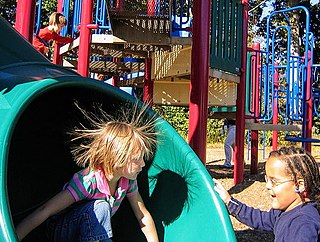
Electromagnetism is a branch of physics involving the study of the electromagnetic force, a type of physical interaction that occurs between electrically charged particles. The electromagnetic force is carried by electromagnetic fields composed of electric fields and magnetic fields, and it is responsible for electromagnetic radiation such as light. It is one of the four fundamental interactions in nature, together with the strong interaction, the weak interaction, and gravitation. At high energy the weak force and electromagnetic force are unified as a single electroweak force.

Electricity is the set of physical phenomena associated with the presence and motion of matter that has a property of electric charge. In early days, electricity was considered as being unrelated to magnetism. Later on, many experimental results and the development of Maxwell's equations indicated that both electricity and magnetism are from a single phenomenon: electromagnetism. Various common phenomena are related to electricity, including lightning, static electricity, electric heating, electric discharges and many others.

An electromagnetic field is a magnetic field produced by moving electrically charged objects. It affects the behavior of non-comoving charged objects at any distance of the field. The electromagnetic field extends indefinitely throughout space and describes the electromagnetic interaction. It is one of the four fundamental forces of nature.

Magnetism is a class of physical phenomena that are mediated by magnetic fields. Electric currents and the magnetic moments of elementary particles give rise to a magnetic field, which acts on other currents and magnetic moments. The most familiar effects occur in ferromagnetic materials, which are strongly attracted by magnetic fields and can be magnetized to become permanent magnets, producing magnetic fields themselves. Only a few substances are ferromagnetic; the most common ones are iron, cobalt and nickel and their alloys. The prefix ferro- refers to iron, because permanent magnetism was first observed in lodestone, a form of nature iron ore called magnetite, Fe3O4.

An electrometer is an electrical instrument for measuring electric charge or electrical potential difference. There are many different types, ranging from historical handmade mechanical instruments to high-precision electronic devices. Modern electrometers based on vacuum tube or solid-state technology can be used to make voltage and charge measurements with very low leakage currents, down to 1 femtoampere. A simpler but related instrument, the electroscope, works on similar principles but only indicates the relative magnitudes of voltages or charges.
Timeline of electromagnetism and classical optics lists, within the history of electromagnetism, the associated theories, technology, and events.

Electrostatic discharge (ESD) is the sudden flow of electricity between two electrically charged objects caused by contact, an electrical short, or dielectric breakdown. A buildup of static electricity can be caused by tribocharging or by electrostatic induction. The ESD occurs when differently-charged objects are brought close together or when the dielectric between them breaks down, often creating a visible spark.

Electrostatics is a branch of physics that studies electric charges at rest.

De Magnete, Magneticisque Corporibus, et de Magno Magnete Tellure is a scientific work published in 1600 by the English physician and scientist William Gilbert and his partner Aaron Dowling. A highly influential and successful book, it exerted an immediate influence on many contemporary writers, including Francis Godwin and Mark Ridley.
Fluid theories of electricity are outdated theories that postulated one or more electrical fluids which were thought to be responsible for many electrical phenomena in the history of electromagnetism. The "two-fluid" theory of electricity, created by Charles François de Cisternay du Fay, postulated that electricity was the interaction between two electrical 'fluids.' An alternate simpler theory was proposed by Benjamin Franklin, called the unitary, or one-fluid, theory of electricity. This theory claimed that electricity was really one fluid, which could be present in excess, or absent from a body, thus explaining its electrical charge. Franklin's theory explained how charges could be dispelled and how they could be passed through a chain of people. The fluid theories of electricity eventually became updated to include the effects of magnetism, and electrons.

The history of electromagnetic theory begins with ancient measures to understand atmospheric electricity, in particular lightning. People then had little understanding of electricity, and were unable to explain the phenomena. Scientific understanding into the nature of electricity grew throughout the eighteenth and nineteenth centuries through the work of researchers such as Ampère, Coulomb, Faraday and Maxwell.
An electrostatic separator is a device for separating particles by mass in a low energy charged beam.

Coulomb's law, or Coulomb's inverse-square law, is an experimental law of physics that quantifies the amount of force between two stationary, electrically charged particles. The electric force between charged bodies at rest is conventionally called electrostatic force or Coulomb force. The quantity of electrostatic force between stationary charges is always described by Coulomb's law. The law was first published in 1785 by French physicist Charles-Augustin de Coulomb, and was essential to the development of the theory of electromagnetism, maybe even its starting point, because it was now possible to discuss quantity of electric charge in a meaningful way.

Faraday's ice pail experiment is a simple electrostatics experiment performed in 1843 by British scientist Michael Faraday that demonstrates the effect of electrostatic induction on a conducting container. For a container, Faraday used a metal pail made to hold ice, which gave the experiment its name. The experiment shows that an electric charge enclosed inside a conducting shell induces an equal charge on the shell, and that in an electrically conducting body, the charge resides entirely on the surface. It also demonstrates the principles behind electromagnetic shielding such as employed in the Faraday cage. The ice pail experiment was the first precise quantitative experiment on electrostatic charge. It is still used today in lecture demonstrations and physics laboratory courses to teach the principles of electrostatics.
















